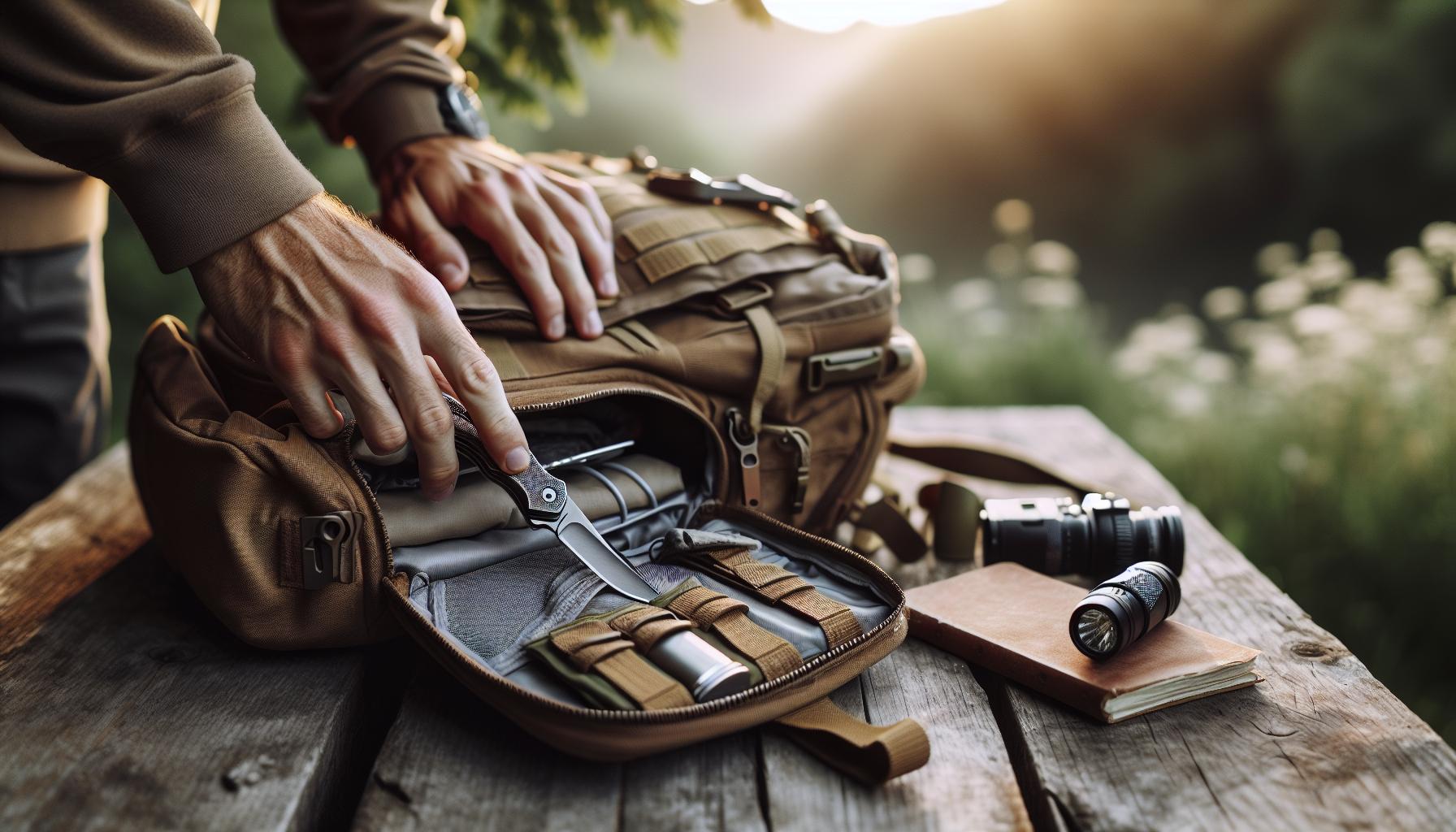Did you know that the pocket knife can opener has been a staple tool for campers and home chefs alike for decades? This versatile gadget not only makes opening cans easier but also adds immense utility to your everyday carry (EDC) gear. Mastering its use can be a game-changer, whether you’re preparing a quick meal outdoors or need to access stored food in an emergency.
In this guide, we’ll walk you through the essential techniques for using a pocket knife can opener safely and effectively. You’ll discover best practices to enhance your skills, ensuring that you tackle any can opening task with confidence. Whether you’re a seasoned enthusiast or a beginner looking to expand your toolkit, this guide provides valuable insights that empower you to make the most of this often-overlooked tool. So grab your pocket knife, and let’s delve into the world of can opening mastery together!
Understanding the Pocket Knife Can Opener Functionality
Using a pocket knife can opener can be a real game changer, especially during outdoor adventures or emergency situations. Unlike traditional, bulkier can openers, a pocket knife can opener is compact and versatile, making it an essential tool for anyone who enjoys camping, hiking, or simply being prepared for the unexpected. Understanding how this specific functionality works, along with its unique mechanics, is vital for maximizing its utility.
The can opener function on a pocket knife typically features a sharp, pointed blade or a specially designed prong that allows you to puncture the lid of a can. To use it effectively, you align the pointed edge with the rim of the can and apply pressure to puncture and create an opening. Unlike a traditional can opener, which requires a smooth action around the lid, the pocket knife can opener often relies on a manual approach that puts you in full control of the process. This level of control can be beneficial when dealing with stiff or oddly shaped cans that standard openers may struggle with.
For effective usage, it’s crucial to maintain a steady hand and ensure you’re applying sufficient pressure. A common question beginners might have is about the proper angle and positioning of the blade. Holding the knife at around a 45-degree angle with the blade’s tip toward the rim optimizes your leverage and precision while reducing the risk of slipping. Additionally, knowing the right can opening technique will not only make the process easier but also safer, minimizing the chances of injury from slips or accidental cuts. With practice, this skill can turn your pocket knife into a reliable kitchen companion in the wild.
Essential Features of a Pocket Knife Can Opener
Using a pocket knife can opener can transform meal prep during outdoor excursions and emergency situations. Unlike traditional can openers, which can be bulky and cumbersome, a pocket knife can opener is designed for portability and versatility. This compact tool distills the essence of functionality into a small space, making it a crucial addition to any camping gear or emergency kit. Understanding the can help you make the most of this handy tool.
A key feature that sets pocket knife can openers apart is their sharp, pointed blade or prong design. This specific shape allows users to easily puncture the lid of a can, which is ideal when you need to access food quickly. The ability to exert manual control over the opening process is particularly useful for navigating difficult can designs. When using a pocket knife, the tool typically remains attached to the handle, ensuring that you never misplace it during use. Additionally, some models include a safety lock mechanism, which prevents accidental closure of the blade during operation, providing an added layer of security.
Another important aspect is the material and build quality. Most pocket knife can openers are made from durable stainless steel, ensuring longevity and resistance to rust. This is essential for the variable environments you might encounter outdoors. Many users appreciate a textured handle, which enhances grip and minimizes the risk of slips while applying pressure. Furthermore, some pocket knives come with a multi-functional aspect, integrating other tools like screwdrivers or scissors, which can prove invaluable in various scenarios beyond just opening cans.
In conclusion, a pocket knife can opener’s portability, unique design, and material quality make it an indispensable tool for anyone who values efficiency and preparedness. Whether you’re hiking, camping, or simply need a reliable can opening solution, understanding these essential features will help you choose the right tool and use it with confidence. Always remember that with practice, you can master the art of utilizing your pocket knife can opener effectively, turning it into your go-to instrument in any situation.
Step-by-Step Guide: Using Your Pocket Knife Can Opener
Using a pocket knife can opener is not only a practical skill but also a valuable one, especially for outdoor enthusiasts and those who prefer self-sufficiency in food preparation. Mastering this tool can transform the way you handle canned goods, whether you’re on a camping trip or in a survival situation. Below is a straightforward guide to effectively using your pocket knife can opener.
To begin, ensure you have a firm grip on your pocket knife. If your model features a safety lock, be sure to engage it before use to avoid accidental blade closure. Then, locate the can’s lid and determine the best spot to puncture it with the sharp point of the can opener. Aim for the edge of the lid, as this is generally the most effective point to penetrate safely.
Puncturing the Lid
– Position the tip of the can opener against the chosen spot on the can lid.
– Apply gentle pressure backward, using your other hand for stability. Consider placing your thumb on the top for additional control.
– Once the tip pierces the lid, rotate the opener in a circular motion or leverage it back and forth to widen the puncture.
Opening the Can
– With the hole created, insert the blade deeper into the lid, ensuring you’re still holding the can steady.
– Gradually lift the blade to create a lever effect, prying open the lid. This motion may require some persistence, as certain cans can be more resistant than others.
– Once you have lifted the lid sufficiently, either continue prying until it’s fully detached or push it down gently if it’s designed to stay attached.
When utilizing any pocket knife can opener, always prioritize safety. Keep your fingers well away from the blade’s path, and be cautious of sharp edges, especially after puncturing the can. Many users accidentally cut themselves on jagged edges, so remaining alert throughout the process is crucial.
This skill not only empowers you to effectively manage your food needs but also enhances your overall confidence in using multi-tool systems. With practice, you’ll find that using a pocket knife can opener becomes a quick and effective solution, whether you’re out in the wild or managing emergencies at home.
Common Mistakes When Using a Pocket Knife Can Opener
Using a pocket knife can opener might seem straightforward, but many users unwittingly fall into common pitfalls that can lead to frustration, injury, or damage to the tool. Recognizing these pitfalls can significantly enhance your experience and effectiveness with this versatile tool.
One significant mistake is neglecting to ensure a secure grip on both the knife and the can. If the can slips while you’re trying to puncture the lid, not only does it hamper your progress, but it also poses a risk of cutting yourself. Always stabilize the can with one hand while applying gentle but firm pressure with the can opener. It’s also essential to choose the right angle when puncturing the lid. Many users instinctively plunge the opener straight down rather than aiming for the edge of the lid-this can make it difficult to create a clean puncture and may result in jagged edges and potential injury.
Another common error is rushing through the process. While it might be tempting to hurry, effective use of a pocket knife can opener requires patience and precision. Applying too much force without the right technique can lead to broken blades or damaged can edges. Remember, a slow and controlled approach will yield better results and reduce the likelihood of accidents.
Additionally, many users overlook the importance of cleaning and maintaining their can opener. After use, it’s crucial to remove any food particles and thoroughly clean the tool. Failing to do so can lead to rust or degradation, compromising both the knife’s effectiveness and safety over time. Regular maintenance not only extends the life of your tool but also ensures that it performs optimally when you need it.
By being aware of these common mistakes and taking steps to avoid them, you can master the art of using a pocket knife can opener with confidence and ease. Whether you’re out camping or managing a meal at home, these tips will help you enjoy the benefits of this essential tool without the hassle.
Maintenance Tips for Optimal Performance

One of the keys to ensuring your pocket knife can opener remains an effective tool is proper maintenance. Just like any multifaceted tool, neglect can lead to poor performance or even complete failure when you need it most. Establishing a regular maintenance routine not only prolongs the life of your pocket knife but also enhances its functionality with each use.
To start, clean your can opener after every use. Wash it with warm soapy water, taking care to remove any food residues that might cling to the blades or hinge. Avoid soaking the knife in water, as prolonged contact can lead to rust, especially in the hinge area. Instead, use a soft cloth or sponge to wipe it down. After cleaning, dry it completely, paying special attention to any hard-to-reach areas where moisture can linger.
Another vital aspect of maintenance is regular oiling. A few drops of mineral oil or lubricant designed for knives can work wonders for the smooth operation of your can opener. Apply the oil to the pivot points of the knife, and then open and close the blades several times to ensure the lubricant is evenly distributed. This practice reduces friction, prevents rusting, and keeps the mechanism functioning correctly, making it easier to operate when it’s time to use it.
Finally, inspect your can opener regularly for signs of wear and tear. Check for dull blades that need sharpening or components that may be loose or damaged. If you notice that the blade is losing its sharpness, use a whetstone or sharpening tool designed for pocket knives to bring it back to life. A properly sharpened blade not only makes opening cans easier but also enhances safety by providing cleaner cuts, reducing the chances of accidents from jagged edges.
By incorporating these simple yet effective maintenance practices into your routine, you’ll always be prepared to tackle whatever the outdoors-or your kitchen-throws your way. Taking care of your pocket knife can opener ensures that it remains a reliable partner, whether you’re navigating a camping trip or simply enjoying a meal at home.
Safety Practices While Using a Can Opener
Using a pocket knife can opener can be a handy skill, but safety should always come first. Many enthusiasts appreciate the versatility of these tools, yet overlooking proper handling techniques can lead to accidents. Whether you’re in the kitchen or out on a camping trip, knowing how to safely use your can opener is essential for both effective operation and personal safety.
To start, always ensure you have a stable surface before attempting to open a can. An unstable or moving surface can increase the risk of slips and cuts. Grip the can firmly with one hand while positioning the can opener on the lid. Maintain a firm hold on the knife and use your dominant hand to guide the tool through the metal. This not only allows for better control but also minimizes the risk of the knife slipping.
When operating the can opener, focus on the cutting action and your surroundings. Being mindful of your other hand is crucial; position it away from the area where the blade is working. If at any time you feel resistance, pause and check to ensure that you’re not forcing the blade, which can lead to accidents. Sometimes, it’s advisable to gently rock the knife back and forth to allow it to cut through the metal more cleanly.
After successfully opening the can, be cautious of the sharp edges that remain on the lid. Use a spoon or similar tool to remove the lid rather than your fingers. This will help prevent cuts from jagged metal. Additionally, always dispose of can lids responsibly; they can be sharp hazards for both people and pets.
In summary, practicing safe techniques while using a pocket knife can opener will not only ensure you avoid injuries but also enhance your efficiency with this versatile tool. Enjoy your culinary adventures or camping meals, but keep these safety practices in mind to ensure a smooth experience every time.
How to Choose the Right Pocket Knife Can Opener
Choosing the right pocket knife can opener is not just about selecting an effective tool; it’s about understanding your needs and the specific features that enhance your experience. With a plethora of options available, focusing on key factors such as ergonomics, blade material, and portability will enable you to make an informed decision.
When evaluating the ergonomics of a pocket knife can opener, consider how the handle feels in your hand. Grip comfort is critical, especially during prolonged use. Look for models with textured grips or rubberized coatings that provide stability, preventing slips during operation. Additionally, the opening mechanism should be intuitive; some designs may feature a locking mechanism that keeps the blade securely in place, enhancing your safety while using the tool.
Blade material is another significant aspect to consider. Stainless steel is a popular choice for durability and corrosion resistance, making it ideal for outdoor use or exposure to moisture. Some high-end models may feature specialty materials such as carbon steel, which can hold a sharper edge longer but may require more maintenance. Think about your typical usage scenarios-if you plan on using your pocket knife can opener in harsh environments, a sturdier blade will be essential.
Lastly, portability plays a crucial role, especially for those who carry their pocket knife regularly. A compact design that fits comfortably in your pocket without adding excessive weight is ideal. Some can openers come with attachment points or clips for easy access and security, eliminating the risk of losing your tool during adventurous outings.
By carefully assessing these factors, you can choose a pocket knife can opener that not only meets your practical needs but also enhances your overall outdoor experience. A well-chosen tool will serve you for years, whether you’re in the kitchen or on a camping trip, combining functionality with ease of use.
Comparative Analysis: Pocket Knife Can Openers vs. Traditional Can Openers
When weighing the advantages of pocket knife can openers against traditional can openers, one must consider versatility and space efficiency. Pocket knife can openers are typically multi-functional tools designed for outdoor enthusiasts, making them invaluable for camping, hiking, or emergencies. Their compact nature allows them to fit snugly in a pocket or bag, making them accessible yet unobtrusive. In contrast, traditional can openers-while effective-are often bulkier and less convenient for on-the-go scenarios.
Advantages of Pocket Knife Can Openers
Using a pocket knife can opener means you’re equipped for more than just opening cans. These tools often include various attachments such as knives, screwdrivers, and even bottle openers, catering to a broader range of tasks. The portability also means they can be with you in unexpected situations where traditional tools are left behind or impractical to carry. Furthermore, pocket knives tend to feature robust materials, providing durability that can withstand outdoor conditions and intricate designs that cater to ease of use.
Strengths of Traditional Can Openers
On the other hand, traditional can openers excel in their dedicated function. Their design focuses solely on efficiently opening cans, often with ergonomic handles and mechanisms tailored for this job. Users might find that they can apply more leverage and control, especially with larger cans or tougher lids. Additionally, for households where can opening is a frequent chore, having a traditional can opener in the kitchen can simplify the process, as they often require less technique than pocket knife variants.
Considerations for Use
When deciding which to use, think about context. If you’re on a day hike or in the great outdoors, a pocket knife can opener ensures you’re ready for anything from meal prep to minor repairs. Conversely, if you’re in a kitchen scenario, a traditional can opener might be more efficient and comfortable for frequent use.
Ultimately, both tools serve distinct yet complementary purposes. Familiarizing yourself with the strengths and limitations of each will empower you to select the right tool for your needs, allowing for confident and responsible usage in various scenarios.
Practical Scenarios for Using a Pocket Knife Can Opener

When you’re out in the wilderness or simply enjoying a day at the beach, the last thing you want to worry about is having the right tool to open a can of beans or soda. That’s where a pocket knife with a can opener comes in handy, taking versatility to a new level. Imagine you’re on a camping trip, and after a long day of hiking, you’re ready to whip up a meal only to find you need to open a can. Having a pocket knife can opener means you can tackle these kinds of situations efficiently, without scrambling for specialized tools.
A pocket knife can opener is not just an essential tool in outdoor activities; it’s also practical in urban settings. Picture this: you’re at a friend’s barbecue, and you find that they’ve forgotten to bring an opener for a can of drinks. Having a pocket knife with you can save the day, allowing you to easily pop open that can and keep the socializing going. Furthermore, for those who enjoy DIY projects at home, a pocket knife with multiple functionalities-including a can opener-can also assist in various tasks around the house, from minor repairs to opening packages.
For emergency preparedness, carrying a pocket knife with a can opener is a smart choice. In survival scenarios, where every ounce of weight matters, being equipped with a multi-tool that provides the ability to open canned food can make a significant difference. Not only does a pocket knife enhance your capabilities outdoors, but it also offers peace of mind knowing you’re ready for unexpected repairs or culinary needs.
In short, a pocket knife can opener isn’t just a novel tool; it’s a reliable companion that excels in both everyday and emergency situations. Next time you plan an outing or simply want to be prepared at home, consider keeping a pocket knife handy to tackle a variety of tasks effortlessly.
Packing Your Pocket Knife for Outdoor Adventures
When embarking on an outdoor adventure, the right gear can make all the difference, and a pocket knife is your versatile companion in this journey. However, knowing how to pack it effectively is essential to ensure that you have quick access to your can opener and other tools when you need them the most. Proper packing can prevent damage, allow for safe transport, and ensure that your pocket knife is ready for any task-be it opening a can of beans for dinner or making improvised repairs.
First, consider your backpack’s layout. Your pocket knife should be stored in a secure yet easily accessible pocket or compartment. A designated side pocket is ideal, as it allows you to reach for it quickly while keeping it protected from the heavier gear that tends to shift during your trek. Additionally, consider using a sheath or pouch to further protect the blade and can opener. Many knife manufacturers offer compatible pouches that not only fit snugly but also provide added protection against dirt and moisture.
It’s also prudent to keep your pocket knife alongside other essential items that may be needed simultaneously. For instance, consider packing it with a small first aid kit and a multi-tool, which can be useful for various tasks. This way, you won’t have to dig through your entire bag when an urgent need arises. Another key tip is to check the weight and size; carrying a lightweight, compact knife prevents unnecessary bulk while still providing you with the tools you need.
Lastly, don’t forget about safety and legality. Depending on your location, certain knives may have restrictions. Research local laws regarding carrying knives in outdoor areas. Ensure your blade is sheathed and secured when not in use to avoid any accidents while rummaging through your backpack. Not only does this practice keep you safe, but it also prolongs the life of your pocket knife and ensures that your can opener function is always ready for action when you need it.
Legal Considerations for Carrying Pocket Knives

Understanding the legal landscape surrounding pocket knives is crucial for anyone who plans to carry them, particularly during outdoor activities. Laws can vary significantly not only by country but also by state, region, or municipality. Familiarizing yourself with local regulations can prevent unnecessary legal hassles and enhance your confidence when using your pocket knife can opener.
Many jurisdictions have specific restrictions on the types of knives you can carry, their size, and how they can be carried. For instance, some places may allow pocket knives with blades shorter than a certain length, while others might prohibit folding knives with locks or assisted-opening mechanisms. When traveling, it’s essential to check the laws of each area you pass through, particularly if they differ from where you live. You can often find this information on official state websites or through local law enforcement agencies.
Additionally, it’s important to consider the context in which you’re carrying your pocket knife. Carrying a knife openly in some public spaces may attract unwanted attention or violate regulations against weapon carry in certain environments such as schools, airports, or government buildings. To navigate these situations safely, always keep your knife sheathed and avoid displaying it unnecessarily.
Lastly, when attending outdoor events, festivals, or volunteer opportunities, check the event’s rules regarding knives. Many gatherings have specific guidelines about what attendees can bring. Being informed not only ensures you’re respecting the law but also shows consideration for the event organizers and fellow participants. Remember that responsible carry and use of your pocket knife reflect positively on the outdoor community and promote safety for everyone involved.
Essential Accessories for Your Pocket Knife Toolkit
When it comes to maximizing the utility of a pocket knife, having the right accessories can transform your experience from ordinary to exceptional. A well-equipped pocket knife toolkit not only enhances your efficiency while using your can opener but also ensures safety and convenience in various scenarios. Consider integrating the following essential accessories to elevate your pocket knife proficiency.
Essential Accessories
- Multi-tool Kit: A multi-tool can serve multiple purposes beyond just opening cans, including screwdrivers, scissors, and pliers. This versatility is particularly valuable in outdoor settings or during emergencies.
- Sheath or Holster: A protective sheath or holster keeps your pocket knife secure and accessible. Look for materials that provide durability while ensuring easy retrieval when needed.
- Sharpening Tool: Keeping the blade sharp is crucial for efficient cutting, especially when using the can opener feature. A portable sharpening stone or honing rod can help maintain the sharpness of your knife edges, promoting longevity and better performance.
- Cleaning Supplies: Regular maintenance is key to ensuring your pocket knife functions smoothly. A small brush to remove debris, along with lubricant for the joints, can enhance performance and reduce wear over time.
- Paracord or Utility Rope: Having some sturdy rope on hand can be incredibly useful for various applications in the outdoors, from setting up a shelter to securing gear. Look for paracord that can handle different weight thresholds.
- Carabiner Clip: This accessory allows you to easily attach your pocket knife to a belt loop, bag, or harness. A carabiner can also serve as a quick-release for other tools or items you may need to access swiftly.
Carrying these accessories not only enhances the functionality of your pocket knife but also prepares you for unexpected situations, allowing for quick fixes or adjustments on the go. By assembling a thoughtful toolkit, you ensure that you’re ready to tackle any task that comes your way, whether on a camping trip, during outdoor adventures, or in daily life. Remember, preparation is key to mastering your tools and maximizing their potential in practical scenarios.
Q&A
Q: How do you choose the right pocket knife can opener?
A: To select the appropriate pocket knife can opener, consider the blade design, size, and ease of use. Look for features like a sturdy handle, integrated safety mechanisms, and compatibility with your typical can sizes. Exploring the section on “How to Choose the Right Pocket Knife Can Opener” in our guide can offer more insights.
Q: What are the benefits of using a pocket knife can opener compared to a traditional can opener?
A: Pocket knife can openers are lightweight and versatile, ideal for camping and outdoor activities where space is limited. They allow for quick access and reduce the need to carry extra tools. For a deeper comparison, check our “Comparative Analysis” section.
Q: Are there any specific maintenance tips for pocket knife can openers?
A: Yes, regular cleaning and oiling are vital for maintaining your pocket knife can opener. After each use, remove debris and wipe down the blade with a cloth. For detailed maintenance tips, refer to the “Maintenance Tips for Optimal Performance” section in our guide.
Q: Can I use a pocket knife can opener on all types of cans?
A: While many pocket knife can openers can handle standard metal cans, they may struggle with oversized or specialty cans. Always check the opener’s design specifications and ensure it’s suitable for the can type you intend to open.
Q: What safety practices should I follow while using a pocket knife can opener?
A: Use the can opener in a stable position and avoid applying excessive force. Always cut away from your body and ensure your hands are clear of the blade. You can learn more about essential safety practices in our dedicated section.
Q: How can I effectively pack my pocket knife can opener for outdoor use?
A: When packing for outdoor adventures, securely store your pocket knife can opener in a protective sheath to prevent accidental openings. Additionally, place it in an easily accessible pocket or pouch. Our guide on “Packing Your Pocket Knife for Outdoor Adventures” offers practical tips for packing.
Q: What common mistakes do people make when using pocket knife can openers?
A: Common mistakes include forcing the blade, using it on the wrong can type, and neglecting maintenance. These errors can lead to injury or tool damage. Consult the “Common Mistakes When Using a Pocket Knife Can Opener” section for a comprehensive overview of pitfalls to avoid.
Q: Are there legal considerations I should know about carrying a pocket knife can opener?
A: Yes, laws regarding carrying pocket knives vary by location, often focusing on blade length and knife type. Always familiarize yourself with local regulations before carrying. For more details, check out our section on “Legal Considerations for Carrying Pocket Knives.”
Insights and Conclusions
Thank you for diving into our “How to Use a Pocket Knife Can Opener: Tool Mastery Guide.” Now that you have a solid foundation on utilizing this versatile tool, it’s time to put your skills into action. Remember, mastering the can opener not only enhances your outdoor experiences but also prepares you for everyday scenarios where quick access to tools is essential. Don’t hesitate to explore our other guides on Swiss Army knives and karambits to expand your knowledge and skills further.
Consider subscribing to our newsletter for insider tips and exclusive content that will help you become a more confident and responsible tool user. Got questions or personal experiences to share? We want to hear from you-drop a comment below! Plus, if you’re interested in safety tips or gear comparisons, check out our related articles linked here for more insights. Keep honing your skills and happy adventuring!


